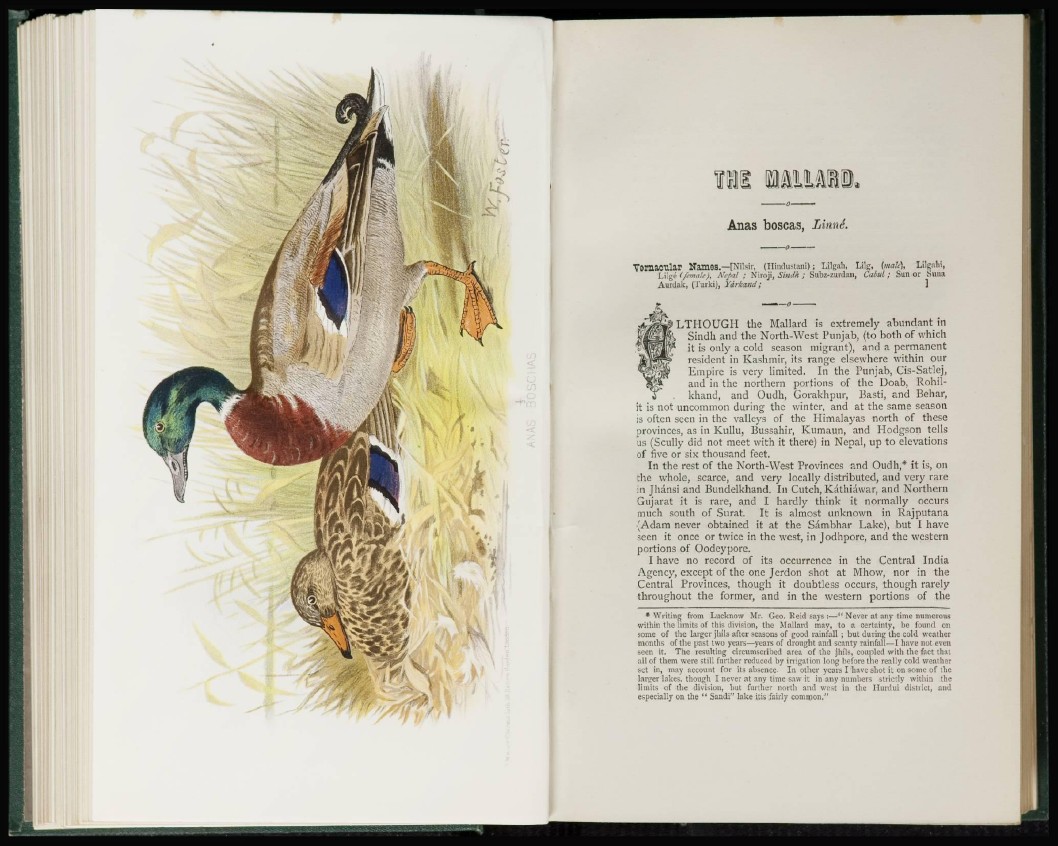
Anas boscas, Linné.
Vernacular Names.—[Nilsir, (Hindustan!); Lilgah, Lilg, (male), Lilgahi,
Lilg^ (female), ATepal ; Niroji, Sinil/i ; Subz-zurdan, Cabul ; Sun or Suna
Aurdak, (Turki), Yarkand; 1
-^jlfig LTHOUGH the Mallard is extremely abundant in
JrtjIIPs Sindh and the North-West Punjab, (to both of which
I S l f ? 's 0 I 1 ' y a c o ' c ' season migrant), and a permanent
Wwfp resident in Kashmir, its range elsewhere within our
Empire is very limited. In the Punjab, Cis-Satlej,
>f » and in the northern portions of the Doab, Rohili
khand, and Oudh, Gorakhpur, Basti, and Behar,
it is not uncommon during the winter, and at the same season
is often seen in the valleys of the Himalayas north of these
provinces, as in Kullu, Bussahir, Kumaun, and Hodgson tells
us (Scully did not meet with it there) in Nepal, up to elevations
of five or six thousand feet.
In the rest of the North-West Provinces and Oudh,* it is, on
the whole, scarce, and very locally distributed, and very rare
in Jhansi and Bundelkhand. In Cutch, Kathiawar, and Northern
Gujarat it is rare, and I hardly think it normally occurs
much south of Surat. It is almost unknown in Rajputana
(Adam never obtained it at the Sambhar Lake), but I have
seen it once or twice in the west, in Jodhpore, and the western
portions of Oodeypore.
I have no record of its occurrence in the Central India
Agency, except of the one Jcrdon shot at Mhow, nor in the
Central Provinces, though it doubtless occurs, though rarely
throughout the former, and in the western portions of the
* Writing from Lucknow Mr. Geo. Reid says :—" Never at any time numerous
within the limits of this division, the Mallaid may, to a certainty, be found on
some of the larger jhiis after seasons of good rainfall ; but during the cold weather
months of the past two years—years of drought and scanty rainfall—I have not even
seen it. The resulting circumscribed area of the jhils, coupled with the fact that
all of them were still further reduced by irrigation long before the really cold weather
set in, may account for its absence. In other years I have shot it on some of the
larger lakes, though I never at any time saw it in any numbers strictly within the
limits of the division, but further north and west in the Hurdui district, and
especially on the " Sandi" lake itis fairly common."